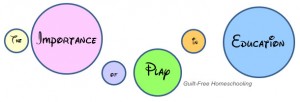This is part of a series of articles based on actual questions I have received and my replies to them. Real names will not be used, and I will address my responses to a generic “Mom”; if you are a homeschooling Dad, the advice can usually be applied to you as well. The wording will be altered from the original letters (and often composed from parts of multiple letters) and personal details will be omitted or disguised in order to protect the privacy of the writers while still maintaining the spirit of the question. If you have a specific homeschooling question that you would like me to address, please write to me at guiltfreehomeschooling@gmail.com. If part of your letter is used in an article, your identity will be concealed.
Dear Carolyn,
I am trying to homeschool my children and keep track of the toddler, but my current pregnancy has upset our whole routine. How in the world will I keep up with homeschooling while caring for a new baby??? I find my strength is diminishing as the size of my tummy increases. I do not have the energy to do all of the household chores that I usually do, and my children are not very helpful in picking up the slack. Some days, I have hit my emotional limit and become a screaming maniac toward my poor children. Again, I am really worried about how I will ever be able to manage homeschooling and housekeeping when the newborn arrives. Any advice?
–Mom
I will not pretend that anyone can wave a magic wand and solve all of your problems with one quick *POOF*, but I can offer some encouragement and maybe a few helpful hints and shortcuts.
Do not try to look too far into your future — do not consider the entire school year, do not consider this entire semester or even one month at a time. Right now, with Baby on the way, you need to deal with one day at a time. Once Baby arrives, you may need to shorten that to even just an hour at a time or 30 minutes at a time. I am serious. Dealing with shorter blocks of time will keep you from becoming completely overwhelmed. Take life in small bites — it is easier to digest that way.
Everyone can learn to do their part in helping out — as long as you give them responsibilities and the expectation that they can accomplish those tasks. Do not try to do everything yourself — not even everything that you have always done up to this point. As Baby’s arrival nears, your physical abilities will become more limited and your attention will be required in more places than before. Explain to your children that they have now matured to the position where they can assume new challenges and new responsibilities — even the toddler can learn to help out with folding washcloths or dusting the furniture legs that you can no longer bend over far enough to reach.
There is no crime in being pregnant! Your children know that you are pregnant, but they also need to learn that being an adult does not exempt a person from feeling tired, angry, frustrated, or overwhelmed (and that goes at least double for being a pregnant adult). Both boys and girls need to learn that pregnancy brings hormonal shifts: as potential fathers and mothers, they need to know what to expect, so do not try to mask all of your symptoms, putting on a happy face and unintentionally giving them the wrong impression. You do, however, want to show them that adults can and will admit their own shortcomings and apologize when necessary. A heart-felt apology can soothe the most hurt feelings, and the hugs that accompany an apology bring tremendous healing.
Although I did not go through a pregnancy during our homeschooling years (so you are free to ignore my advice if you wish), I did have many incidents from other outside factors that stressed me enough that it overflowed into our “classroom.” I learned (eventually) to recognize the source of the irritation, and I learned (eventually) not to blame my students for things they had not caused. I also learned (eventually) that humbling myself before my children, apologizing, and asking them to pray for Mommy to be able to handle things better worked wonders. We became closer, more forgiving, and more patient and tolerant through each trial. At one point, a foot problem limited me to do no standing or walking for several days, so my children came up with the solution of seating Mommy in a wheeled office chair and pushing the chair (with me in it) from room to room. The resulting giggles from all of us brought more healing than just the physical “rest” could have.
Let your physical limitations be known — to yourself as much as to the rest of your family. Then sit down, put your feet up, and enjoy being hugely pregnant for a few more weeks. Accept the offers from friends to bring in a meal or stop by to vacuum the floors for you. Call your church or a close friend and ask for help if no one has realized that you need some help now, before Baby is born. Let each older child take a turn at entertaining and caring for the toddler for a little while each day, giving them an opportunity for bonding and giving you a short break and a time to focus your attention on the other children. Realize that peanut butter and jelly sandwiches can be a nutritious supper. Realize that it will not matter if the kitchen counters do not sparkle or if the sink has a few dirty dishes in it. The “homeschool cops” will not come to your door and haul you away merely for letting your family eat from paper plates or scaling back the lessons to just reading and math for a while.
Responsible, older children can be given the privilege of checking their own work for some subjects. The math books we used had an answer key that could show my students whether or not they had arrived at the correct answer. A separate solutions manual guided them step-by-step through the solving process when they were truly stumped. When consulted honestly (after completing the work, not before), answer keys and solution guides can teach as much as the lesson itself does. Those same older students can also serve as teaching assistants with their younger siblings, helping the youngsters scan their work for glaring errors before submitting it to Mom’s checking pencil. Every step a student takes toward checking his own work takes him that much closer to being an independent learner, something that will be very valuable when he makes the jump from homeschooled student to college student.
Once Baby has arrived, your strength will begin to return, but you can continue to give your children more responsibilities in the daily upkeep of your home. After all, it is their home, too, and lessons in cooking, cleaning, laundry, and home maintenance would be referred to as an Independent Living class by most public school programs. Enduring a pregnancy while homeschooling will be a learning and growing process for all of you, and one that will reap tremendous benefits. Do not underestimate the lessons that your children will learn through it.
For more encouragement, see these additional articles:
Do the Best Job You Can, and Pray for God to Clean Up the Rest
Your Children Will Not Always Be Like This
Using Your Household Staff
Family Is Spelled T-E-A-M
Teach Your Students to Teach Themselves
Teaching with Preschoolers Around… and Under… and on Top… and Beside
Guilt-Free Lesson Plans and Scheduling
People LIVE in This House
What Is Your “Best”?
Biblical Model of Discipleship
Sick Days, Snow Days, and Other Interruptions





 Guilt-Free Homeschooling is the creation of Carolyn Morrison and her daughter, Jennifer Leonhard. After serious disappointments with public school, Carolyn spent the next 11 years homeschooling her two children, from elementary to high school graduation and college admission. Refusing to force new homeschooling families to re-invent the wheel, Carolyn and Jennifer now share their encouragement, support, tips, and tricks, filling their blog with "all the answers we were looking for as a new-to-homeschooling family" and making this website a valuable resource for parents, not just a daily journal. Guilt-Free Homeschooling -- Equipping Parents for Homeschooling Success!
Guilt-Free Homeschooling is the creation of Carolyn Morrison and her daughter, Jennifer Leonhard. After serious disappointments with public school, Carolyn spent the next 11 years homeschooling her two children, from elementary to high school graduation and college admission. Refusing to force new homeschooling families to re-invent the wheel, Carolyn and Jennifer now share their encouragement, support, tips, and tricks, filling their blog with "all the answers we were looking for as a new-to-homeschooling family" and making this website a valuable resource for parents, not just a daily journal. Guilt-Free Homeschooling -- Equipping Parents for Homeschooling Success!

Recent Comments